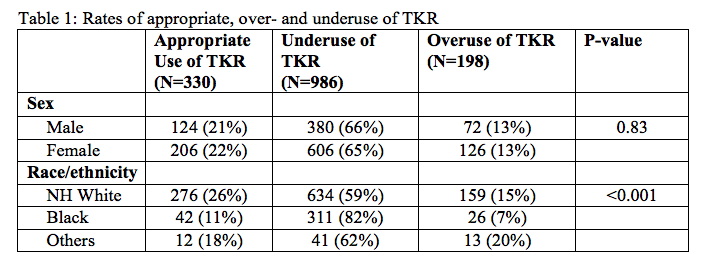Presenting Author:
Principal Investigator:
Department:
Surgery
Keywords:
total knee replacement, appropriate use criteria, overuse, underuse, knee osteoarthritis
Location:
Ryan Family Atrium, Robert H. Lurie Medical Research Center
C137 - Clinical
Quantifying TKR Overuse and Underuse: Implications for Racial Disparities
Background: Utilization of total knee replacement (TKR) is on the rise and projections of a 6-fold increase over the next 2 decades have concerned policy makers, with several initiatives aimed at restraining costs.1 Yet, TKR underuse, was recognized by an NIH consensus panel in 2004, and is acknowledged as a high priority by policy makers as well.2,3 Little is known about the scope of TKR overuse and underuse.4 Available knowledge in this area is based mainly on studies examining racial and ethnic TKR disparities in rates of actual surgeries, without attention to those needing the surgery but not utilizing it.4-6 The aim of this study was to determine the rates of overuse and underuse of knee replacement in a cohort of knee osteoarthritis (OA) patients, and to determine if these rates varied by gender and race/ethnicity categories. Methods: We applied the modified Escobar appropriate use criteria (AUC) to a cohort of knee OA patients enrolled in the Osteoarthritis Initiative Study to determine their need for TKR on an annual basis for 6 consecutive years. The AUC classifies participants as either appropriate, inappropriate, or maybe appropriate for surgery based on their functional status, pain, age, number of knee compartments involved, and range of motion. The modified AUC has shown good predictability of patient-centered outcomes 2 year following surgery in TKR patients (appropriate and maybe appropriate showed significant improvement while inappropriate patients showed little improvement).7,8 We then assessed the temporal relationships between appropriateness for and actual use of TKR. We compared those who were appropriate or maybe appropriate and had TKR (Appropriate Use), those who were appropriate or maybe appropriate and did not have TKR (potential Underuse), and those who were inappropriate and had TKR (Potential Overuse). We compared rates for males and females as well as across race and ethnicity groups. Results: The Osteoarthritis Initiative Study recruited 4976 of whom 1514 fell into one of the groups at one time during the follow-up period. There were 330 (21.8%) in Appropriate Use group, 986 (65.1%) in the Potential Underuse group, and 198 (13.1%) in Potential Overuse group. We did not find any sex differences between the groups; however; we found significant racial differences between the groups, with significant potential underuse observed in blacks (Table 1). Conclusions: Our study shows that underuse, although more prevalent among blacks, was also observed quite frequently among other races/ethnicities. In addition, overuse was observed across racial categories, including among blacks. These findings provide new insights about the racial gap in TKR utilization, and underscore the need to investigate factors that are associated with both overuse and underuse of this effective surgical procedure.

